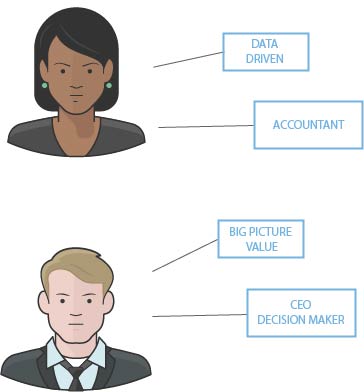The old saying is that “content is king.” That’s true, but it’s not everything. If you’re looking to start a B2B content marketing program, you need the king … and his entire court.

According to the Content Marketing Institute,
“Content marketing is a strategic marketing approach focused on creating and distributing valuable, relevant and consistent content to attract and retain a clearly defined audience – and, ultimately, to drive profitable customer action.”
Huh?
At its core, B2B content marketing is about raising visibility, earning credibility, establishing expertise and building a strong, mutually beneficial relationship with target audiences, which include both prospects and influencers in your industry:
- by distributing high-quality, useful content
- at the right frequency
- at the right time
- in a variety of formats (short-form, long-form, infographic, video)
- through a variety of channels (public relations, digital advertising, email, social, paid social, your own website)
[cta-full]The goal of a content marketing strategy to attract clearly defined target audience(s) – and (eventually) get prospects to give you something of value (their contact information or a request for appointment/demo) in exchange for the valuable, educational stuff you provide.[/cta-full]
A B2B content marketing program is about raising visibility, earning credibility, establishing expertise and building a strong, mutually beneficial relationship with target audiences.
In many respects, content marketing is integrated marketing. It is a multi-channel, multi-discipline, highly measurable, long-term strategic framework. That means it doesn’t happen overnight.
That said, if you’re ready and willing to put in the time, energy and elbow grease to build an effective content marketing machine, here’s how to get started.
Key Questions to Ask Before You Start a B2B Content Marketing Program:
- Do you have a clear understanding of your business’ place in the market … and a clear understanding of your audiences?
- What does your marketing technology stack look like?
- What content do you have? How much content do you have to create?
- How do I get my content in front of my audiences?
- How do I make sure my content marketing strategy is working and having an impact?
1. Do you have a clear understanding of your business’ place in the market … and a clear understanding of your prospects?
No matter how big or small your business or your market, the first step to making a dent is understanding your place – and your lane forward. Start with a deep dive into your business, beginning with review of key documents and systems, analysis of existing digital efforts and a long look at the search engine universe around your business and product offering.
The goal here is to connect with and solidify your brand. This goes beyond what you’re selling or doing and is about finding your authentic voice and identifying true differentiators that helps your brand stand out in a crowd. And there are no shortcuts to be taken here.
Once you’ve gotten an understanding of marketplace realities – and your place in that reality – you’ll want to spend some time establishing highly actionable buyer personas.

For example, prospects are going to need content that speaks to alleviating the pain points they’re having … and help them understand why your product or service is the one that will help to fix their problems.
Persona development should not be a bloated exercise where we spell out that one buyer type likes long walks on the beach and Pomeranians. That is irrelevant fluff. Persona development is about understanding the targets’ role in their organizations, their pains and hot buttons, their objections and hurdles, and how your solution – and expertise – can best help them.
Looking to recruit top talent? That will require a very different message.
For each persona, the goal of this stage is to answer the question of “Who should receive what message when, and how will we reach them?”
This, naturally, is the crux of an editorial plan and calendar, which dictates the timing, tone, tenor and success metrics of tactical efforts going forward for your B2B content marketing program.
The goal of this stage is to answer the question of “Who should receive what message when, and how will we reach them?”
Armed with a clear understanding of needs and preferences, embark upon a thorough competitive review, including both a qualitative review of competitors’ offerings and market presence and quantitative analysis of digital marketing footprints.
2. What does my marketing technology stack look like?
Now that you know who you are, who you want to talk to and the messages you need to deliver to them, take a look at the marketing technology infrastructure you have in place – a key component of launching a B2B content marketing program.
Maybe you need to start from scratch – either because you’ve never effectively deployed marketing technology or your current set up is insufficient or simply comprised of the wrong tools for the realities, parameters and constraints of their distinct situation.

If, on the other hand, you have a well-vetted, reputable marketing technology stack in place, it’s time to test it with a fresh set of eyes to ensure it’s doing what is needed, you’re getting the most of what you’re paying for and you’re maximizing the automation it enables. If there are six human hands touching six different tools, you’re probably not getting all you can from the automation benefits.
3. What content do I already have? How much content do I have to create?
A B2B content marketing program wouldn’t be anything without, well … content.
Before you start writing feverishly, take a look at what you’ve already got. Have you ever done a company video, overview brochure, blog or infographic? Have any of those pieces done well to drive traffic to your site? If so, start there. There’s no need to reinvent the wheel, especially if you’ve been creating content for several years. If your checklist on how to build the perfect taco from five years ago consistently drives traffic, update it – keeping the same URL – and re-distribute across all your channels.
This adds a lot of value to your SEO rankings. Those old posts are like the investments you make in a 401(k) account. Out of sight, but behind the scenes they’re adding up and building interest as time goes on. Which is why keeping the same URL is key.
If you are starting from scratch, remember that “content” does not mean “written word.” At least not exclusively.
Content comes in many forms – infographics, videos, experiences. And yes, long-form articles, blogs, social media posts, case studies, white papers, primary research reports, and other types of customized content are valuable.
How often do you need to produce something?
While the type, quantity and frequency of content produced is driven by the over-arching content marketing plan and budgetary parameters, there is no written rule that you need to produce fresh content as a daily conquest.
For a B2B content marketing program, quality beats quantity any day of the week. The key is to remember your audience and create content that is valuable to them and answers a question or alleviates challenges they may be facing. Resist the urge to be overtly salesy.
And don’t think about creating content in a vacuum. Think about how the content being developed will address the pain points of your prospects. When you’re doing this, think about how to help them to find this valuable content and do some key phrase research.
[callout button_link=”#” button_text=”Go”]Download Our Free Guide to Integrated Marketing[/callout]
Before you start a B2B content marketing program, ask yourself, “If I were looking for this kind of solution, what would I type into the Google search bar?” Verify your gut with keyword research tools, and use an SEO checklist or plugin (Yoast is great) to verify that your on-page optimization looks right.
One note of advice in setting up keyword and key phrases for your brand: Be specific. Some industries are incredibly competitive. If you are a startup insurance software provider, for example, the likelihood of showing up on page 1 on Google’s SERP for the search term “insurance” is not happening. Top rankings there are owned by sites with domain authorities of 75 and higher. That’s a logarithmic scale, and getting above 60 or so takes years.
Of course, a startup that makes policy admin software for inland marine carriers doesn’t need to rank for “insurance.” They need to rank for their specific long-tail term – “policy administration software for inland marine.” There, the top relevant rank is owned by NetRate Systems, with a domain authority of just 28 … and they’re not even a policy admin provider. That’s a realistic, relevant ranking goal.
4. How do I get my content in front of my audiences?
There are a multitude of ways to distribute your content. When you start a B2B content marketing program, you’ll have to evaluate all of them.
Primary drivers: Primary drivers represent targeted outreach and a prospect’s first engagement with a brand. Examples in B2B marketing include organic search, pay-per-click advertising, programmatic advertising, direct outreach via third-party datasets, second-party data share advertising, sponsored content, survey invitations and more. Additional primary drivers include public relations, media relations and social media marketing efforts.
Retargeting: This form of advertising automatically delivers brand messages and advertisements to users who have engaged but not yet shown clear mid- or low-funnel buying behavior. This is primarily a cost-per-click (CPC) model, and has the added benefit of delivering potentially hundreds of thousands of impressions for free.
Email marketing: Automated email workflow with specific messages, offers and calls to action dictated by a prospect’s past behavior.
Custom notifications and trigger points: Outreach is great but needs to tie back to sales. Depending on the marketing technology stack you employ, you’re able to set up rules and auto-generate notifications to specific salespeople or company leadership so that they can do personal outreach with a warm or hot lead.
5. How Is Content Marketing Success Measured?
Every B2B content marketing strategy (and campaign piece) is different, but typical metrics include:
- Pipeline growth and attributable sales
- Sales-qualified leads
- Marketing-qualified leads
- Audience/list growth
- Advertising/sponsored content clicks
- Advertising impressions
- Website traffic
- Website engagement (e.g., time on site, pages per visit, user flow)
- Email engagement (i.e., opens and clicks)
- Asset downloads
You should start with a baseline and continuously review metrics through the marketing technology stack you’re using and test changes in methodically. Always test. And always make metrics available – typically directly fed from a system of record – 24/7/365 to those that need to see, review and act upon the information.
A B2B content marketing program is a complex, multi-disciplinary strategy that takes time and effort to develop and execute, but when done right – and when it involves not just the content king but a couple of knights, rooks and bishops to execute and pull the levers – it can have significant impacts on your sales and bottom line.





